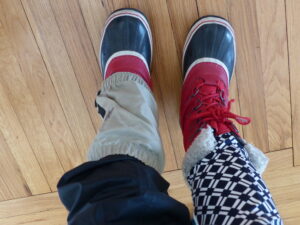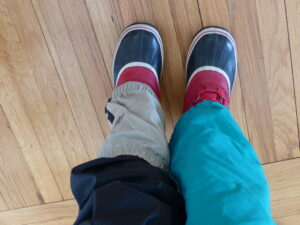We were starting to pack for a winter trip to visit our Alaskan daughter when she called. “Bring gaiters along with your snowshoes,” she said. That sparked a lively conversation between us and piqued our curiosity.
Marion calls the item of clothing that keeps snow and dirt from getting into boots gaiters. Rich calls them spats. Who’s right? Well, we both are. Gaiters, spats, puttees, chaps, and leg warmers all are designed to protect legs, ankles, or feet from snow, dirt, or the cold. Some add a flair of fashion to their role of protection and they can be mostly decorative.
Gaiters
Gaiters are modern and popular with winter outdoor enthusiasts. Usually made of nylon or another synthetic fabric, they fasten over pant legs and shoes to keep grime and snow out. Unless a skier or snowshoer likes cold wet feet, gaiters are essential. Some gaiters have a chemical coating that helps protect from ticks, too.
- Ways to protect feet and legs.
- Long or short it is up to you.
Spats
Spats go way back. Rich remembers his Army days when soldiers wore bright white spats during formal ceremonies and parades. Spats is a shortened word for spatterdashes. Military ones were made of white canvas and may still be. Spats are usually short and worn over the lower trouser legs and shoes. Back a century ago stylish men and women often wore fancy spats on dress-up occasions. Today heavy-duty spats are made for protection, rather than fashion, and are worn by welders and construction workers to protect their feet and ankles from sparks and heavy falling objects.
Puttees
Pity the poor World War I soldiers who had to live in filthy, muddy trenches. Often, they wore puttees in an attempt to keep cold, grimy slime out of their shoes and off their lower legs. The Canadian War Museum explains that a puttee is a length of, usually, cotton material, somewhat like a bandage roll, that was wound around the ankle, lower pants legs, and upper parts of shoes. They were likely no match for a trench’s muck. Puttees are hardly ever used today and the name is nearly lost.
Leg Warmers
Leg Warmers emerged from a dancewear shop in the East Village. Designed to keep dancers’ legs and feet warm, they because fashion accessories. The 1983 movie Flashdance and Jane Fonda with her workout videos helped popularize these practical, stylish accessories throughout the ‘80s. They’re long tubes of colorful warm fabric that fit tightly over much of the legs. They haven’t gone away. Usually, they’re worn by women.
Chaps
Chaps are still another clothing item that are worn over the legs for protection. Cowboys wore them to fend off thorns. Loggers use them to protect their legs from wayward sharp chainsaw teeth. Rich spent a season logging in Idaho, where they were spelled chaps but pronounced shaps. Idaho’s unusual. In most other places people use the “c” sound. Chainsaw chaps have the amazing ability to stop a speeding chain’s teeth before tearing into the operator’s legs. They’re strictly for protection and anyone running a chainsaw is wise to wear them.
So, are they gaiters or spats? Do you pronounce them chaps or shaps? Take your pick, but however they are pronounced or called leg and ankle coverings offer protection, and some can be downright stylish. Just another way to be prepared in Iowa.




Steve and I purchased gaiters several years ago to keep our lower pant legs dry when walking inn-to-inn through wet, unmowed pastures in England. We still use them today when wading through tall, wet grass for our Sierra Club group’s roadside cleanup. They are very useful. When Steve owned a motorcycle, we wore leather chaps for protection, along with leather jackets and helmets. The motorcycle is long gone and so are the chaps. And yes, it’s “chaps” with a C!
Sheri, love this! thanks for sharing. M~
I loved this article. I was always baffled by spats when I was in marching band in the late 70’s. I wore them in the high school band and in the American Legion Marching band where I was paid $5 a parade to fill in.
Thank you, Sharon, for this throwback memory!